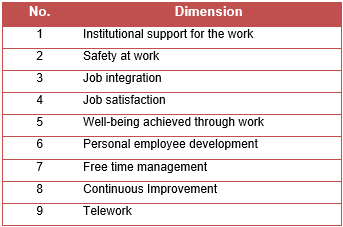
Source: Own elaboration
Measurements of the quality of working life in companies of the city of Córdoba 2021
(*)Nélida del Carmen Castellano
(*)Escuela de Graduados en Ciencias Económicas
Posdoctorado "Retos Poblacionales Actuales"
nelicast@gmail.com
Reception date: 08/28/2021 - Approval date: 09/02/2021
DOI: https://doi.org/10.36995/j.visiondefuturo.2022.26.02.003.en
ABSTRACT
This project is the second part of the one presented in 2020 and integrates the Program "Current Population Challenges", where we have included the Quality of Working Life (QWL), since it is a current population challenge to study its components and the factors that affect it: unemployment, underemployment, job insecurity, economic crisis, gender issues that have not been overcome in years, preconceptions about the lower decision-making capacity of women compared to men, among others.
Last year, we built an integrating and overcoming model of the components of the QWL, based on CVT-GOHISALO-2018 (Brief), with 7 dimensions and incorporated: a dimension on Continuous Improvement and a dimension to evaluate the impact of quarantine due to COVID-19 on people's work, Teleworking.
The main conclusion of the first part of the project was the elaboration of a questionnaire based on the integrating and overcoming model of the components of the QWL.
This second part presents the application of this questionnaire to companies in the city of Córdoba, both industrial and service, to measure the different variables of the model reflected in the questions of the digital form, analyze them and draw conclusions.
KEYWORDS: Quality of working life; Continuous Improvement; Teleworking; Structural Equation Modeling; Job satisfaction.
INTRODUCTION
This project is the second part of the one presented in 2020 and integrates the "Current Population Challenges" Program, where we have included the Quality of Working Life (QWL), since it is a current population challenge to study its components and the factors that affect it: unemployment, underemployment, job insecurity, economic crisis, gender issues that have not been overcome in years, preconceptions about the lower decision-making capacity of women as compared to men, among others. In recent months, an additional, unthinkable and serious factor, such as the Covid-19 pandemic, has made people's work and therefore this concept even more complex.
Last year, we built an operational model of the components of the QWL, based on CVT-GOHISALO-2018 (Brief) with its 7 dimensions, to which we incorporated: a dimension on Continuous Improvement, composed by the factors of permanent training and continuous learning and a dimension to evaluate the impact of the quarantine by COVID-19, in the Telework of people.
The main conclusion of the first part of the project was the elaboration of a questionnaire based on the integrative model obtained from the analysis and comparison of the existing studies on the components of QWL, which was considered to be superior to the existing ones.
In this second part, we applied the questionnaire to companies in the city of Córdoba, both industrial and service companies, to measure the different variables of the model reflected in the questions of the digital form, analyze them and draw possible conclusions from the responses of the employees of the companies that answered the questionnaire.
Research questions
The research questions from the first part of the project were taken into account in the elaboration of the comprehensive overcoming model. From that model, 43 questions emerged and were included in the digital questionnaire that was applied to the selected companies, which is shown in Table No. 2.
Research problem
In this second part of the project, our research problem is a recurring one during the fieldwork to collect data: getting organizations to allow their employees to answer the digital questionnaire sent to them.
We had determined that the population in which we would investigate the factors or components that affect the Quality of Working Life would be made up of organizations in the city of Córdoba, taken from the list of the Secretary of Commerce and Industry of the Province of Córdoba. This was not possible, because this Secretary did not work during the year 2020 in person, some reduced sectors did it remotely, but they never responded to our request for the list to work in our research project.
For this reason, we addressed our request for dissemination of the questionnaire to the UIC (Industrial Union of Córdoba) and to several chambers: CIMCC: Chamber of Metallurgical and Components Industrialists of Córdoba, CIIECA: Chamber of Computer, Electronic and Communications Industries of Central Argentina, Chamber of Wood Industrialists, among other minor ones. We also sent the form to the industrial entrepreneurs in our database, formed by the attendees to the SAMECO Córdoba Regional Meetings. We also addressed our request to FADeA S.A. (Fábrica de Aviones S.A.). In all the above-mentioned cases, they received our request willingly and with many promises, but the answers to the questionnaire were actually very few.
We continue at this moment, with the reiteration of our requests before the mentioned organisms, waiting for a greater number of answers to continue completing the field work, but we have cut with the ones we have up to this moment to present this work.
General Objective
To achieve the application of the digital questionnaire in the largest number of companies in the city of Cordoba, allowing their employees to answer the questions in order to carry out the measurements and analysis, and thus draw the corresponding conclusions.
Specific Objectives
A. Conceptual Framework
Concept of Quality of Working Life (QWL)
The conceptual framework of this second part of the project is the same as that detailed in the first part, when the existing models on the components of Quality of Working Life were surveyed. Then, through the methodology of study and comparative analysis, the objective of creating an integral model was achieved, incorporating new dimensions of study of the QWL, which were the Continuous Improvement and Teleworking.
Impact of Total Quality on Administrative Discipline
Total Quality or Total Quality Management (TQM), applied especially in the 1990s. brought profound changes to the management discipline. No other management philosophy or methodology had such a strong impact on management as Total Quality did. This subject has been one of our objects of study, elaboration of articles and exposition in events, since 2008 onwards.
The following groups of changes brought about by the philosophy of Total Quality in Management stand out, which have a direct impact on the Quality of Working Life, as we will see below:
Changes in the Dynamic Processes
For this work we are interested in deepening in the variables that shape human behavior (studied by behaviorism) called Dynamic Processes. These refer to the fluids that circulate through the structure of an organization, such as: leadership, motivation, conflict and communication. Since Total Quality Management, all of them have been modified with the higher objective of generating Quality of Working Life. The main dynamic processes identified are the following:
Specifically, we were interested in studying ongoing training and continuous learning, as we consider them to be fundamental characteristics of Kaizen or Continuous Improvement.
Impact of Continuous Improvement on the QWL
Continuous training emerges as a consequence of a cultural change, where great importance is given to the training of personnel at all levels. The ulterior meaning is that training is never-ending, new knowledge and skills must always be learned. The objective of the system is also used to evaluate employee development. Before we build cars, we build people; this proverbial Toyota phrase illustrates very well the great importance of employee development. Therefore, employee development must rank high in the system's objectives. The process can only be as good as the employee. For this reason, both must be developed equally. (U. Dombrowski, T. Mielke, 2014).
Continuous learning is another expression of cultural change, which transforms employees into beings deeply interested in all the organization's processes and in their continuous improvement (Kaizen), with a permanent curiosity in the activities that surround them and in the possibility of change and optimization. Learning must take place in short cycles. Problem solving and learning must be done in a standardized way and based on the PDCA or PHEA cycle (Plan, Do, Check, Act). Numerous regular repetitions and a scientific experiment approach to the various tasks are essential. (U. Dombrowski, T. Mielke, 2014).
We include these two elements: ongoing training and continuous learning, within the Continuous Improvement dimension that we added to the model we built.
Impact of Telework on the QWL
The Covid-19 quarantine has forced us to change many of our daily habits including work; we do it from home with the telework modality, also called home-office (G. Esbry, 2020).
According to the Survey of Labor Indicators (EIL) of the National Ministry of Labor, before the pandemic, less than 8% of workers did so remotely, 70.4% were young men employed in Technology Services. Now more than 40% do so, reaching peaks of 85%. Another interesting data is shown by the International Network of Education for Work (RIET), 63% of those who did telework would like to continue with this form.
Teleworking has pros and cons for both companies and workers; for the former it reduces costs and promotes greater productivity, but it complicates the capacity for supervision and coordination. For the latter, it reduces transportation times and costs and improves work-life balance, but it is difficult to regulate work schedules and to have the necessary IT tools.
We include Telework caused by the Covid-19 quarantine as another dimension for the overcoming model we elaborated.
B. State of the Art
The State of the Art was completed with the review of current publications that attempt to determine the components or factors that impact QWL and establish a measurement. Among these publications, those that contributed to the conceptual framework and measurement methodology were selected and presented in the section called Development of the first part of the project.
Methodology
In the first part of the project, we applied as a methodology, the study and comparative analysis of the different models and schemes collected from the selected bibliography, which was specific and updated.
In the Development section, the publications selected for their interest in the contributions to the conceptual framework, the new conditions or components considered for the study of QWL and the models they presented, considering the multidimensional nature of the concept of QWL, were included.
In this comparative study, we also added the conditions and components originated in the impacts of Total Quality (Continuous Improvement) in the Dynamic Processes of the organizations, which have had as a higher objective, the highest Quality of Working Life for all workers. Likewise, we consider the effects of the quarantine by Covid-19 in the Telework of the people and therefore, in the QWL.
In this way, we have developed an overcoming and integrating model that is as complete as possible, due to the greater quantity and quality of the factors or components of the QWL, which we hope will be useful to managers for decision making.
Based on this integrative model, we constructed a digital questionnaire containing the dimensions indicated above, which is shown in Table No. 3, and conducted a pilot test to determine the level of understanding of the questions, which was satisfactory.
In this second part of the project, we sent the digital questionnaire to be answered by the collaborators of many companies, but as we indicated in the Research Problem, we received many promises and fewer responses. We classified these into two groups: industrial companies and companies in the health sector. In total, surveys from 53 organizations were processed.
DEVELOPMENT
Integrating and overcoming model of the components of the QWL
Based on a review of works by the main authors on the components of QWL, we took the CVT-GOHISALO-2010 model as a basis because it has been validated and there are numerous precedents for its use in studies on the multidimensional concept that concerns us.
We compared it with the operational models proposed by several authors, among them Granados and Becerra, to identify the coincidences between the factors of each model. Likewise, and as was the objective of the present work, the Dynamic Processes were included in the comparison.
With the aim of achieving an operational model that surpasses and integrates most of the dimensions identified as relevant for the study of QWL, we decided to use the model CVT-GOHISALO-2018 (Brief) based on the original one of 2010 and consisting of 7 dimensions. We completed it with a dimension referring to Continuous Improvement and another one on the impact of the Covid-19 quarantine on people's Telework, which are shown in Table No. 1.
Table No. 1: Dimensions (Latent Variables) of the Model

Source: Own elaboration
The 9 dimensions of the model constructed have 43 observable variables or indicators, which are presented in Table No. 2.
Table No. 2: Questionnaire (Observable Variables or Indicators)
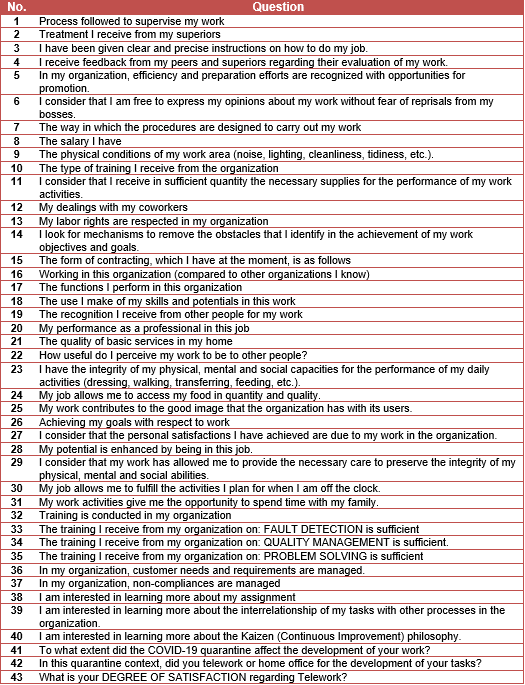
Source: Own elaboration
Data collection
We sent the digital questionnaire to a large number of companies in the city of Cordoba, as mentioned above, through the UIC and several chambers. We also sent it directly to organizations in our database. A total of 53 responses were received: 16 from the industrial sector and 37 from the health sector.
Data processing
Quality of Working Life (QWL) as a social phenomenon is an abstract concept of great complexity and can only be measured through indicators that manifest it. To analyze the causal relationships between the phenomenon (construct) and its indicators (observed variables), a multivariate analysis technique called Structural Equation Modeling (SEM) was used to examine the effect of the dimensions identified on QWL.
In the SEM technique, the variable that is the effect is called the endogenous or explained variable and those that originate or cause the former are the exogenous or explanatory variables. Although these models analyze causal relationships, it is necessary to clarify that they do not prove causality, but facilitate the selection of relevant causal hypotheses, eliminating those that are not supported by empirical evidence. In this sense, causal models are susceptible to being statistically rejected if they contradict the data, so the real value of the tool is to specify complex relationships between variables a priori and then evaluate which of these relationships are represented in the empirically collected data (Weston and Gore, 2006).
Using an SEM will allow us to study the so-called constructs, which cannot be observed and measured directly, but from different observable indicators (Bruno and Caro, 2019).
For our case study of the components of the QWL, the Dimensions (Latent or Explained Variables) and the Questions (Observable Variables - Indicators or Explanatory) that arise from the integrating and overcoming model constructed are presented in Table No. 3.
Table No. 3: Structural Equation Model - QWL: Dimensions and Variables
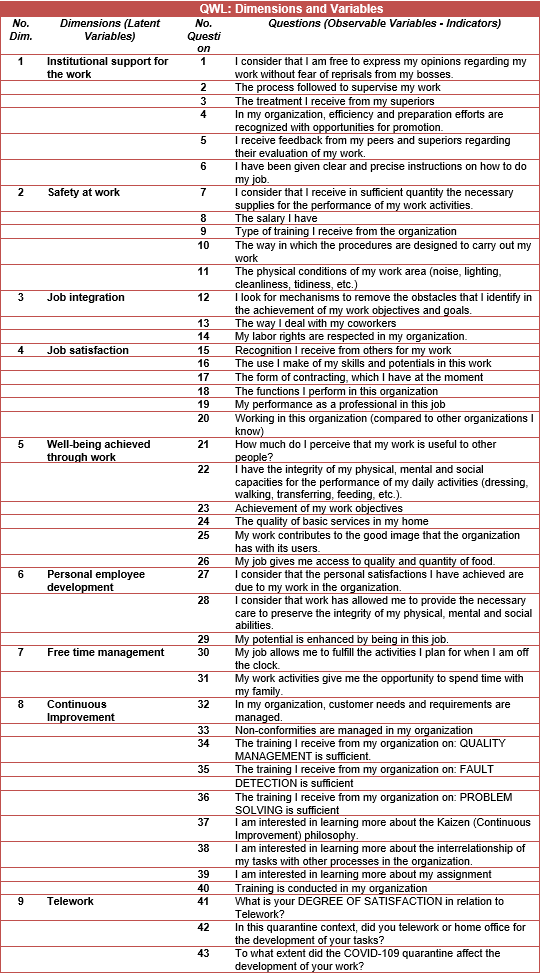
Source: Own elaboration
Calculation method
As explained above, the object of the study is to apply an SEM to evaluate QWL in organizations in the city of Córdoba, by means of latent variables that are measured based on observable variables.
In this sense, in order to obtain a measurement of each of the dimensions studied, the calculation method used consists of taking the respondents' answers for the observable variables and calculating an average for the dimension that contains them.
The observable variables (questions) in the questionnaire are ordinal categorical and were measured using a 5-level Likert scale. Although the levels of this type of scale are usually associated with a numerical value to process the data, as if the variable were numerical, we preferred to summarize the information using the proportion of responses at each level (presented as a percentage) to respect the categorical nature of the variables.
Likewise, and to facilitate the graphic interpretation of the information, the levels were associated with a traffic light-type color scale, in which the lowest level is represented by the color red and the highest level by the color green.
Results: answers to the questionnaire
The graphs elaborated with the answers to the 7 dimensions of the Model CVT-GOHISALO-2018 (Brief), plus that of Continuous Improvement and Teleworking by Covid-19 are presented: Graph No. 1: Answers of the Industrial Companies and Graph No. 2: Answers of the Companies of the Health Sector.
These horizontal bar charts were constructed from the Structural Equation Model (SEM), where the construct is Quality of Working Life, the latent variables are the 9 dimensions defined above and the observable variables or indicators are the 43 questions of the digital questionnaire, as shown in Table 2.
Graph No. 1: Responses from Industrial Companies
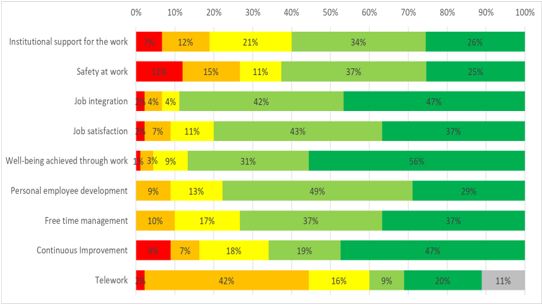
Source: Own elaboration
Graph No. 2: Responses from Health Sector Companies
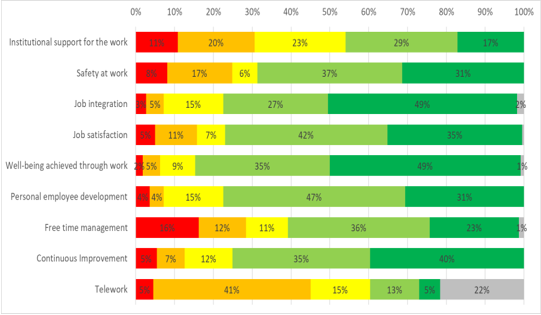
Source: Own elaboration
Analysis and Recommendations
The 7 Dimensions of the Integrating Model
Looking at the graphs corresponding to the two groups of responses, we see that the Industrial Companies have 5 of the 7 dimensions of the QWL with low values (satisfaction, frequency, agreement) which is shown in red. These dimensions with red values are: Institutional support for work 7%, Job security 12%, Job integration 2%, Job satisfaction 2% and Well-being achieved through work 1%. The first two are worrisome, as they respond to very sensitive aspects of the QWL. The remaining 3 responses with low values show minimal percentages, so they do not constitute immediate alerts for managers; however, the recommendation is to study the aspects that make them up in order to achieve the elimination of negative perceptions.
In the Health Sector Companies, the 7 dimensions of the QWL have low values. We consider the values in red for the dimensions Time Off Management 16%, Institutional Support for Work 11% and Safety at Work 8% to be of great concern, given that these are very sensitive components of the QWL that affect the tasks performed by health personnel. We believe that managers should take immediate action to improve the perception of employees on these aspects of their work.
The dimensions Job satisfaction 5% and Personal development of the employee 4%, contain important aspects for the QWL, so we suggest studying these components to find elements that can change the perception of employees. The other 2 dimensions with low values present small percentages: Job integration 3% and Well-being achieved through work 2%. Despite these lower percentages, we suggest that the aspects that integrate them should also be studied in order to achieve the elimination of negative perceptions in them.
In all dimensions of the graphs corresponding to the two groups of responses, very high and medium high values are observed.
In Industrial Companies, the dark green dimensions with very high values are: Well-being achieved through work 56%, Job integration 47%, Job satisfaction 37% and Leisure time management 37%,
The dimensions Personal development of the employee 29%, Institutional support for work 26% and Job security 25%, are related to the low values of Institutional support for work and Job security, i.e. relatively few employees have a good perception of the components of these two dimensions.
In the Health Sector Companies, the dark green dimensions with very high values are: Job integration 49%, Well-being achieved through work 49%, Job satisfaction 35%, Job security 31% and Personal development of the worker 31%.
The dimensions Leisure time management 23% and Institutional support for work 17%, are directly related to the low values that were analyzed above.
These responses show a lower degree of commitment to the different dimensions and are light green in color.
In Industrial Companies all dimensions have good proportions of these types of responses, namely: Personal development of the worker 49%, Job satisfaction 43%, Job integration 42%, Job security 37%, Leisure time management 37%, Institutional support for work 34% and Well-being achieved through work 31%. This is interpreted to mean that people chose responses that were moderately committed to the aspects of the QWL.
In the Health Sector Companies, all the dimensions also have good proportions of moderate responses, such as: Personal development of the worker 47%, Job satisfaction 42%, Job security 37%, Management of free time 36%, Well-being achieved through work 35%, Institutional support for work 29% and Job integration 27%. In general, it is observed that the moderate responses of this group are slightly lower in percentages than those of the Industrial Companies group.
These answers are marked by people who do not have a formed opinion of the variables of each dimension or do not want to make known their perception in relation to the QWL. They have a yellow color in the graph.
In Industrial Companies all dimensions have some responses of this type, namely: Institutional support for work 21%, Management of free time 17%, Personal development of the employee 13%, Job security 11%, Job satisfaction 11%, Well-being achieved 9% and Job integration 4%. We should interpret these percentages of neutral responses as worrying, as in the first with 21% of employees who do not know if they receive institutional support for work.
In the Health Sector Companies, it can be observed that all the dimensions also have responses of this type, with percentages similar to those of the Industrial Companies. Institutional support for work 23%, Job integration 15%, Personal development of the employee 15%, Management of free time 11%, Well-being achieved through work 9%, Job satisfaction 7% and Job security 6%. We also express our concern about the neutral responses of employees, because it is hard to believe that such a large proportion do not have their opinion formed; it would be worse if the neutral response is because they are afraid to express their perception of the components of the QWL.
The general recommendation that emerges from this analysis is that the responses with low and neutral values are a real reservoir for managers to investigate and discover the causes of this behavior of employees in terms of not openly expressing their true opinion on the components of the QWL.
Continuous Improvement Dimension
In the Industrial Companies, the percentages of responses are: with low values 9%, with high values 47%, with medium high values 19% and with neutral values 18%.
In the health sector companies, these percentages are: with low values 5%, with high values 40%, with medium high values 35% and with neutral values 12%.
These percentages denote the action taken by the managers of the Health Sector Companies in the constant adoption of continuous improvement and the degree of involvement achieved in the personnel.
Telework Dimension
In the Industrial Companies, the percentages of responses are: with low values 2%, with high values 20%, with medium high values 9% and with neutral values 16%. Rarely applied it 42% and did not have the experience 11%.
In the Health Sector Companies, these percentages are: with low values 5%, with high values 5%, with medium high values 13% and with neutral values 5%. Rarely applied by 41% and not experienced by 22%.
The possibility of teleworking was very different for the two groups of responses, since it was carried out more frequently in the industrial companies than in the Health Sector Companies, due to the very nature of the tasks performed.
CONCLUSIONS
1. The Comparative Analysis of the works carried out by the main authors who studied this topic, allowed us to broaden our theoretical knowledge on QWL:
2. Once agreed and accepted, this theoretical knowledge allowed the transfer to a questionnaire as complete as possible, to investigate and measure QWL:
Future lines of research
For the next stage of this project, we are planning the application of a questionnaire on gender aspects, to complement the study of the components of the QWL in organizations in the city of Cordoba.
REFERENCES
Please refer to articles in Spanish Bibliography.
BIBLIOGRAPHICAL ABSTRACT
Please refer to articles Spanish Biographical abstract.